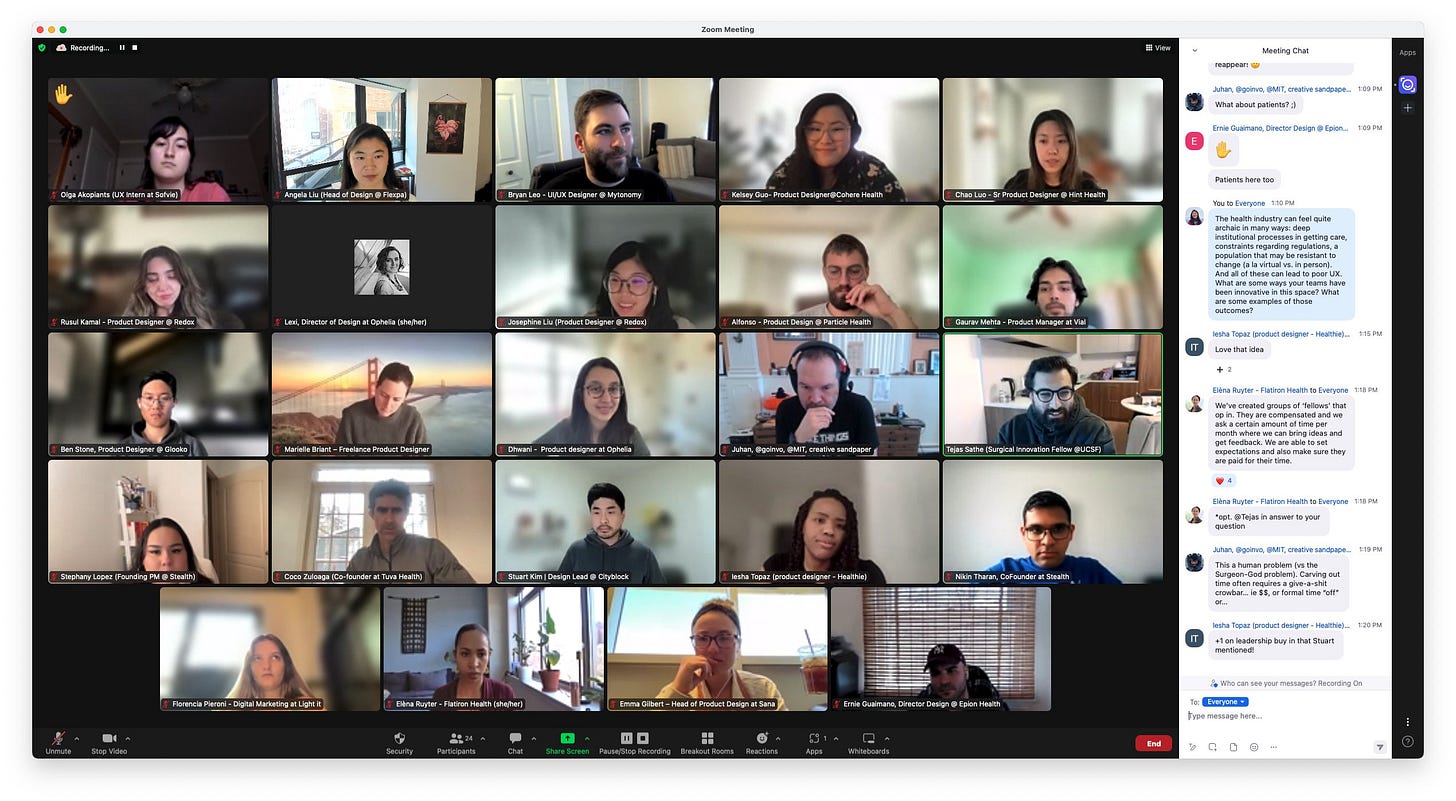Welcome to the Design Rounds substack! (Plus Session 1 recap)
Where we will recap previous Design Rounds, and get jazzed for the next one.
Design Rounds is an allusion to Grand Rounds, which are conducted by doctors to receive feedback and ideas on patient cases. The spirit of our sessions will be much the same. The industry is hyper complex, and there’s never a shortage of helpful feedback from smart minds, so this is a space where we can all bring designs to crit, topics to discuss, or struggles to brainstorm.
By popular demand, I’m creating this email list for those who can’t make the live session, but want to follow along. Next time we’ll have a proper logo, but today we’ll have to settle for the default image placeholder 😅. Onwards!
These sessions are hosted by Angela Liu, Head of Design at Flexpa. Flexpa is the easiest way for applications ranging from value-based care organizations, clinical trials groups, and insurance brokers to connect identified claims data. If that's even mildly interesting to you, then let's chat!
Session 1: Engaging clinicians, consent design, and open source resources
We hosted the inaugural Design Rounds on March 09, 2023 with a whopping 24 participants. Look at all theses beautiful faces representing 20 different companies across the healthcare industry. Half were new to healthcare, half were new-comers. Half were early in their careers, and half were seasoned. 23 were product/design people, and 1 is a clinician (thank you!). Together, we had a vibrant discussion that I’ll recap for you here. If you prefer audio, the full recording is here.
1. Finding innovation in a regulated space
The healthcare industry can feel archaic, with deep institutional processes, regulatory constraints, and a population resistant to change. These factors can lead to poor user experience (UX). We shared ways our teams have been innovative within this space, such as:
Transitioning from printed pamphlets to video content and PDFs for patient education.
Hosting internal hackathons to encourage the development of innovative ideas and proof-of-concepts.
Involving clinicians early in the design process to gather valuable input. One challenge is engaging busy clinicians with half-baked ideas and prototypes. Participants suggested:
Focusing on clinicians who are more open to change and innovation and interested in participating.
Creating groups of fellows who opt-in to provide feedback and are compensated for their time.
Encouraging team members to listen in on customer support calls to better understand user struggles.
2. Designing patient consent forms
What are the challenges of creating patient consent forms that balance legal requirements with user comprehension? We discussed:
The importance of empathy and understanding the user's perspective was emphasized.
The importance of consent particularly in the context of clinical trials, where specific requirements must be met as per FDA guidelines. This often leads to longer onboarding processes to ensure proper consent from patients and doctors.
Involving users in the design process and understanding their needs can lead to more effective and engaging healthcare experiences.
Providing transparency to users through a consent revocation process can increases trust by informing users upfront how to disconnect their data from a service. Demonstrating control over their data helps users feel more secure and confident in the service.
3. Healthcare specific design idiosyncrasies
What are the sector-specific idiosyncrasies in healthcare and design decisions that go against or differ from generalized best practices? We discussed:
The challenges of balancing user trust with streamlined design, particularly with Medicaid users who may be distrustful or frustrated with the system. Designers must decide when to add or remove obstacles for information and find ways to build trust without overwhelming users.
The difficulty of fighting against revenue and growth when advocating for more ethical design practices, especially at startups. The discussion highlights how high conversion rates might mask underlying issues with user understanding and consent.
The challenge of using jargon in healthcare. We discussed the pros and cons of simplifying terminology versus maintaining consistency with industry terms, ultimately concluding that keeping industry terms while providing explanations can help avoid confusion.
4. Lightning Feedback
Shoutout to Stephany, Product lead at a Stealth healthtech startup for being the first to show designs for a lightning feedback session with the group! It can be nerve-wracking putting your designs up for feedback, let alone to a room of 23 strangers, so thanks for setting a great example Stephany!
5. Open source resources in Healthcare
We ended the hour with some food for thought from Juhan on how we can make resources like healthcare design, eligibility service, and diagnosis services more accessible by leveraging open-source aspects in healthcare. Some points the group touched on include:
The need for a common repository for healthcare interfaces and widgets to avoid constant repetition and reinvention of the wheel. (Throwing it back to consent design!)
Explaining to stakeholders and clinicians the relationship between open-source and HIPAA regulations, and that they are not in conflict.
The challenges of implementing open-source solutions in healthcare were highlighted, including licensing, public accessibility, community involvement, and addressing stakeholder concerns about privacy and intellectual property.
An example of an open-source project that provides a standard data model for healthcare measures, offering a possible analogy for design widgets.
Join us for the next session: April 06, 2023! 🎉
I’ll be hosting the session over Zoom from 1-2pm EST on Thursday April 6th. Shoot me an email at angela@flexpa.com if you’d be interested in joining the next Design Rounds.


